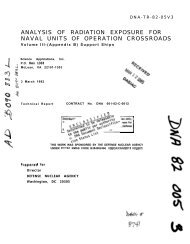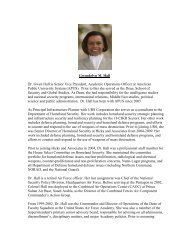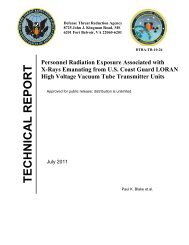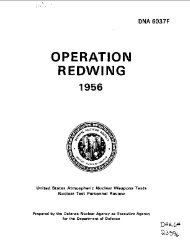Shield - Defense Threat Reduction Agency
Shield - Defense Threat Reduction Agency
Shield - Defense Threat Reduction Agency
You also want an ePaper? Increase the reach of your titles
YUMPU automatically turns print PDFs into web optimized ePapers that Google loves.
fellowships. Th is is where I met John Connell for the interview<br />
and it was like talking to an old friend. By the end of our conversation<br />
I knew DTRA/SCC-WMD was where I wanted to<br />
be. Two weeks later, John called and told me that I was hired<br />
as the Research and Development – Chemical and Biological<br />
Technologies Directorate’s fi rst DTRA/SCC-WMD fellow.<br />
One week after graduating with my doctorate in plant pathology<br />
and toxicology, I started my fi rst program rotation in the<br />
DTRA/SCC-WMD Chemical and Biological Technologies<br />
Directorate working with Fred Crowson, Ngai Wong, Christian<br />
Whitchurch and Brandi Vann. Th ey taught me about the<br />
other side of science… the program management side. My role<br />
was to ensure our supported eff orts met the triumvirate of cost,<br />
schedule and performance while pushing the scientifi c limits<br />
for success.<br />
After one year, it was time to fi gure<br />
out what the next step in my career<br />
would be. I kept hearing about cooperative<br />
threat reduction (CTR)<br />
from John and others, but what did<br />
I care about nukes? Who knew how<br />
wrong I was? John did! I had an opportunity<br />
to cross paths with Capt.<br />
Paul Flood, the project manager<br />
for the Biological Th reat <strong>Reduction</strong><br />
Program (BTRP), in a meeting. He<br />
is a frank man and said “You would<br />
fi t in great with our team. We need<br />
another set of unbiased science eyes<br />
32 / the shield / fall 2011<br />
to strengthen our portfolio.” Capt. Flood wanted me to analyze<br />
their research – with a focus on biothreats – and make recommendations<br />
on how to leverage existing eff orts that will help<br />
BTRP scientifi c endeavors outside of the former Soviet Union.<br />
I agreed to work with CTR, thinking I’d be going back to RD-<br />
CB at the end of my rotation. When my six month rotation was<br />
over, I was off ered a permanent position in CTR-BTRP and I<br />
gladly accepted. I couldn’t pass up the chance to continue to<br />
work with Will Chapman, Chip Karn, the Science and Tech<br />
Team of Gavin Braunstein, Sarah Kennedy, Chris Biegun, and<br />
now Dr. Elizabeth George our new CTR Director. Th e BTRP<br />
position allows me the opportunity to maintain my ties with<br />
RD-CB Physical, Medical, and Basic divisions working on the<br />
“whole of DTRA approach.” Th ese are exciting times!<br />
What I did for CTR and what I continue to do for them is<br />
function as a senior scientifi c project manager.<br />
I pretty much have my hand in everything science-based<br />
that happens in BTRP. Projects are<br />
proposed to us or we try to elicit for projects<br />
with diff erent inter- and intra-agency partners,<br />
non-governmental organizations and academia.<br />
Our delegation of subject matter experts travels<br />
to diff erent countries, visiting laboratory facilities<br />
to understand and address countries’ needs<br />
on the bio front. We observe scientists and lab<br />
technicians perform their work under both good<br />
and bad conditions. I’ve had the opportunity to<br />
(page 31) Dr. Bacetty examines pathogen sample in a Kenya laboratory. (above left) Center for Disease Control visit to Kenya<br />
laboratory. (above) Discussing isolation methods for some zoonotic highly pathogenic strains at the Uganda Viral research<br />
Institute.









